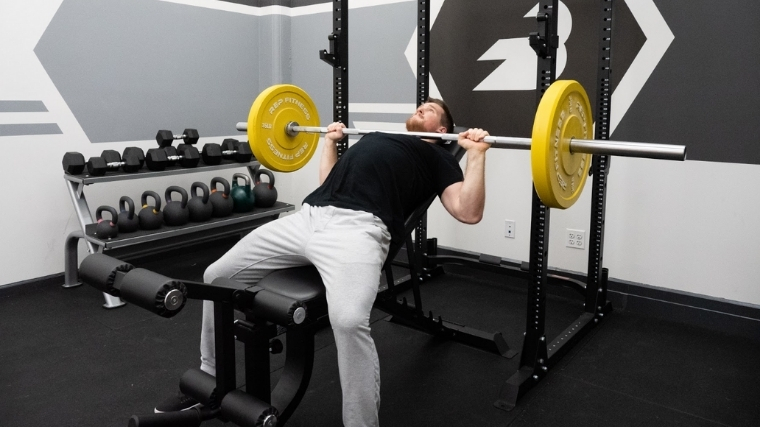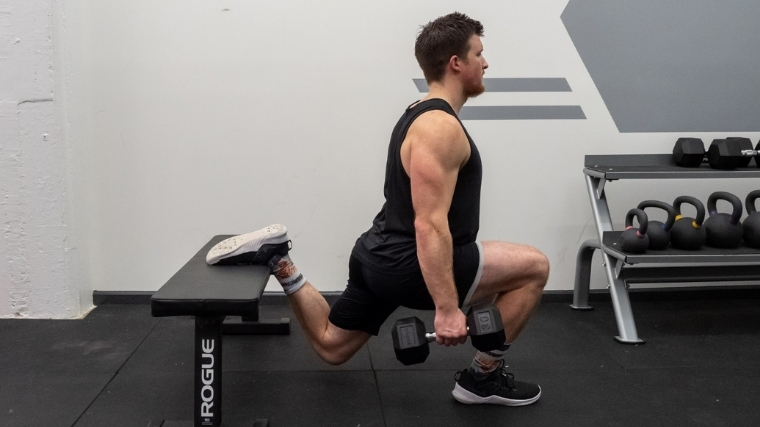You’ve seen it in training templates. You’ve heard athletes mutter it to their coaches in the gym after an intense-looking set. You’ve probably even seen memes about it on strength-specific social media pages. But do you really have a grasp of what RPE — rating of perceived exertion — really means? And how do you use it in your training, anyway?
One of the best-known methods for selecting your weights during training is based on the percentage of your one-rep max. Whenever you see something like 85% hanging out near a rep scheme in your program, you’re looking at a percentage-based session. But sometimes, you’ll see a whole number, between one and 10 — and that will be your RPE. That number indicates that instead of loading up the plates with a pre-determined weight, you’ll lift based on how the weight feels. It gives you that much more control of your program — and gets you more in touch with your mental training. That is if you know how to implement RPE properly.
What Is RPE?
The RPE scale is a way for lifters to subjectively measure the intensity of a lift, which they usually then base the rest of their training day around.
The ratings run from 1-10, one representing a lift that requires little to no effort and 10 being the absolute maximum a person can lift. More experienced trainees usually use the RPE scale since it requires a level of honesty and training wisdom to assess the difficulty of a lift accurately. A beginner may not have pushed themselves to the limit before, so their perception of what’s hard will be vastly different compared to a lifter who has endured heavy 20-rep squats.
RPE Scale
- 10 — At your max, you have no more reps.
- 9 — There’s another rep in the tank, but it’s a grind.
- 8 — You’re beginning to hit your 2-4 rep stride.
- 7 — Often, a weight one can move with power (5-7ish reps).
- 6 — Weight that one can move quickly for speed work (+/- 8 reps pending on speed/training goal).
- 5 — A weight that someone warms ups.
- 4 & below — Light weight that can be used for mobility, recovery, and form emphasis.
These numbers are just a guide. Every athlete and coach should develop their RPE numbers dependent on their training age and understanding of their lifting habits.
How Do You Use RPE In Training?
Instead of prescribing weights ahead of time, based on your one-rep max (1RM), RPE-based programs will look a little simpler. For example:
- Week 1 — 3 sets at RPE 7
- Week 2 — 4 sets at RPE 7
- Week 3 — 5 sets at RPE 7
- Week 4 — 3 sets at RPE 8
This means that you’ll have to use your ramp-up sets with a lot more intention than you might be used to. As you warm up, pay strict attention to your form, how the bar moves, and how many reps you have in the tank. Just because someone can usually perform a warm-up bench set with 185 pounds doesn’t mean they can do it every time. A lifter may be tired, or hungry, or just stressed out.
If your body isn’t feeling it, pay attention. One benefit of using the RPE scale is that you can alter the weight you’re using on the fly compared to a more rigid percentage-based program. Conversely, when you’re feeling good, feel free to slide another weight plate on the barbell.
Of course, if your program calls for a certain number of sets at RPE eight, stick to that. Even if you’re feeling great, keep your RPE at eight with consistent, excellent form for the prescribed number of sets. Loading too much additional weight just because you’re feeling good will either bring you up to an RPE nine or mess up your form. So even though RPE work is subjective, it’s still important to stick to the plan.
Unless you’re doing very specialized rehab work with a coach, you’re very unlikely to see programs call for RPEs less than five. Typically, think of anything easier than that, as in warmup and mobility-training territory.
When Do You Use RPE In Training?
If you’re looking to get stronger but don’t have an accurate gauge of your 1RM, RPE training might be for you. It’ll help you lock in your mental focus — because you have to pay strict attention to how each set feels.
You might also want to use RPE in your training if you’re feeling burnt out or have hit a lifting plateau. While training based on percentages of your 1RM can effectively periodize strength programs, they don’t account for daily life stressors. An athlete training at high intensities for a long duration may be approaching burnout but is still asked to go hard because the program says so.
The beauty of basing your training off of RPE is that “hard” becomes relative. Say the athlete referenced above was supposed to bench press three sets of five reps with 225 pounds. If they’re burnt out and need to hit three sets of five at an RPE seven, maybe their “seven” for the day is closer to 205 pounds.
Even within a percentage-based program, you can use RPE for accessory lifts. You’re likely not going to seek out your one-rep max for overhead tricep extensions, for example. Instead, use RPE for your accessory work to ensure you’re not just standing there pumping weight without intention.
The Science Behind RPE Training
A 2017 study from the Journal of Strength and Conditioning Research looked at the relationship between RPE and velocity during the squat, bench press, and deadlift during a 1RM lift (with powerlifters). The authors found that when athletes hit their 1RM and were asked about RPE, they were generally consistent across the board. The squat, bench press, and deadlift RPEs were 9.6, 9.7, and 9.6 with a +/-.5 variation. Here, a 9.6 would be consistent with an athlete not having one more rep in the tank. This suggests that RPE could be a beneficial tool for prescribing training intensities. (1)
Another finding is that there’s an inverse relationship between bar speed and RPE — meaning, as the RPE increased, the bar’s velocity decreased. (This makes sense, of course, as heavier weight is harder to move.) The authors suggested developing a “velocity load profile” for an even more accurate training intensity prescription. This can be interpreted as documenting your bar speed and relating it to RPE across lift intensities to create a more accurate scale.
A 2016 study, also published in the Journal of Strength and Conditioning Research, compared the use of the RPE/RIR (reps-in-reserve) scale and bar velocity in both experienced and novice lifters (performing squats, to be exact). (2)
- 10 — Absolute maximum.
- 9.5 — Don’t do a mother rep, but maybe increase the weight marginally.
- 9 — You can do one more rep.
- 8.5 — one to two reps in the tank.
- 8 — two reps are left
- 7.5 — two to three reps are left
- 7 — three reps are left
Researches had the lifters split into experienced and novice groups, dependent on their training ages. Squatters performed a 1RM followed by squats at 60, 70, and 90% of their max. Following the completion of the 90% set, lifters performed eight reps at 75% of their 1RM.
Over 93% of the experienced lifters recorded a >9.5 when hitting their 1RM. On the contrary, only a little over 57% of novice lifters recorded a >9 at their 1RM.
The point: Experienced lifters better understand their bodies and what they can handle, which would be why they were more accurate when deciding RPE at high intensities. A novice lifter may underplay the amount they can move for a certain number of reps. For newbies, percentage-based training may be the way to go for a bit.
When it comes to bar velocity, the authors documented an inverse relationship with RPE and velocity for both experienced and novice lifters, which is similar to the previous study. The authors suggest that using RPE/RIR is an effective way for prescribing training intensities in athletes. Therefore, using a reps-in-the-tank model for determining RPE can, indeed, be effective for gaining strength.
What Are The Pros And Cons Of Training Based On RPE?
Of course, there’s no one right answer to whether you should use RPE or percentage-based protocols. What you use will shift depending on your mesocycle, your training season, and your specific goals at any given time. That said, it’s good to know some general advantages and potential pitfalls of RPE programming.
Pro: You Don’t Need To Know Your 1RM
Basing your training on RPE is an excellent tool for athletes who don’t know their 1RM or can’t max out to test it truly. Not all athletes’ programs call for accurately assessing their 1RM, so accurate percentages may not be available to them. Or, if you’re coming back from injury, going off of your effort rather than a pre-injury max lift is a much safer way to proceed. That’s where the subjectiveness of RPE training comes in handy.
Pro: You Can Account for Your Own Recovery And Injuries
Your body can’t always handle sets of squats at 90% of your 1RM, even if your program calls for it. Maybe you didn’t sleep well the night before, or you’re stressed out at work. If you’re using an RPE protocol, you won’t load up 90%, fail, and consider your training session a complete failure. Instead, you’ll settle into lifting — successfully — whatever weight feels like an eight or nine RPE that day.
Con: It’s Less Objective Than Percentages
On the other hand, the subjectivity of the RPE scale can be a detriment to some lifters. If you’re feeling tired, you may rate a lift a nine when on an easier day, you’d call the same lift a seven. That can leave you unsure of whether that set of five at 315 pounds was truly an all-out effort, or if you just forget to eat your eggs that morning.
Training logs come in handy for this reason. You can take note of how you’re feeling alongside your rating in your lifting journal so that you’ll have context later. Still, using RPE to track your training progress isn’t the most objective way to go. If you don’t meticulously log your context, the numbers can mean less and less over time.
Should You Use RPE-Based Training?
If you’re an experienced lifter, want to get stronger, and need a break from 1RM training, then yes. It would help if you had at it with an RPE-based program. Just make sure you’re keeping yourself accountable for your recovery so that you can really make each set count.
More Training Content
Check out these other BarBend articles to help take your training endeavors from up a couple of notches.
- What You Need to Know About How to Increase Strength
- Cluster Sets Are the Intensity Boost Your Workouts Need
- The Ultimate Guide on How to Choose a Barbell
References
- Helms ER, Storey A, Cross MR, Brown SR, Lenetsky S, Ramsay H, Dillen C, Zourdos MC. RPE and Velocity Relationships for the Back Squat, Bench Press, and Deadlift in Powerlifters. J Strength Cond Res. 2017 Feb;31(2):292-297. doi: 10.1519/JSC.0000000000001517. PMID: 27243918.
-
Zourdos MC, Klemp A, Dolan C, Quiles JM, Schau KA, Jo E, Helms E, Esgro B, Duncan S, Garcia Merino S, Blanco R. Novel Resistance Training-Specific Rating of Perceived Exertion Scale Measuring Repetitions in Reserve. J Strength Cond Res. 2016 Jan;30(1):267-75. doi: 10.1519/JSC.0000000000001049. PMID: 26049792.

